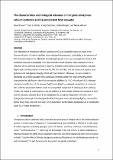Files in this item
The characteristics and biological relevance of inorganic amorphous calcium carbonate (ACC) precipitated from seawater
Item metadata
| dc.contributor.author | Evans, David | |
| dc.contributor.author | Webb, Paul Brian | |
| dc.contributor.author | Penkman, Kirsty | |
| dc.contributor.author | Kroger, Roland | |
| dc.contributor.author | Allison, Nicola | |
| dc.date.accessioned | 2020-07-02T23:36:25Z | |
| dc.date.available | 2020-07-02T23:36:25Z | |
| dc.date.issued | 2019-08-07 | |
| dc.identifier | 260727103 | |
| dc.identifier | 39650ca2-b911-4c85-9e91-5715d003def1 | |
| dc.identifier | 85070681094 | |
| dc.identifier | 000480499600014 | |
| dc.identifier.citation | Evans , D , Webb , P B , Penkman , K , Kroger , R & Allison , N 2019 , ' The characteristics and biological relevance of inorganic amorphous calcium carbonate (ACC) precipitated from seawater ' , Crystal Growth & Design , vol. 19 , no. 8 , pp. 4300-4313 . https://doi.org/10.1021/acs.cgd.9b00003 | en |
| dc.identifier.issn | 1528-7483 | |
| dc.identifier.other | ORCID: /0000-0003-3720-1917/work/60887623 | |
| dc.identifier.other | ORCID: /0000-0003-2532-344X/work/67167800 | |
| dc.identifier.uri | https://hdl.handle.net/10023/20203 | |
| dc.description | This work was supported by the Leverhulme Trust (Research Project Grant 2015-268 to N.A., R.K., and K.P.). The Royal Society is gratefully acknowledged for the award of an Industry Fellowship to P.B.W. | en |
| dc.description.abstract | The importance of amorphous calcium carbonate (ACC) as a precursor phase in the biomineralization of marine calcifiers is increasingly being reported, particularly as the presence of ACC has been observed or inferred in several major groups. Here, we investigate the structure of ACC and the conditions required for its precipitation from seawater-based solutions, with an emphasis on the coinfluence of the carbonate system (pH, dissolved inorganic carbon (DIC) concentration), seawater Mg/Ca ratio, and presence of amino acids. We find that Mg2+ and the presence of aspartic acid, glutamic acid, and glycine strongly inhibit ACC precipitation. Moreover, we were unable to precipitate ACC from seawater with a carbonate chemistry within the range of that thought to characterize the calcification site of certain marine calcifiers (i.e., DIC < 6 mM, pH < 9.3), although substantial modification of the seawater Mg/Ca ratio (Mg/Casw) allowed precipitation at a reduced DIC with the implication that this could be an important component of utilizing an ACC pathway. In addition, the degree to which Mg/Casw and the presence of amino acids influences the structure of ACC and the necessary seawater [CO32–] for precipitation is strongly pH dependent. At lower, more biologically relevant pH than that typical of much inorganic work, decreasing Mg/Casw can result in greater long-range order and less water of crystallization but facilitates precipitation at a considerably lower [CO32–] than at higher pH. | |
| dc.format.extent | 1478987 | |
| dc.language.iso | eng | |
| dc.relation.ispartof | Crystal Growth & Design | en |
| dc.subject | QD Chemistry | en |
| dc.subject | GE Environmental Sciences | en |
| dc.subject | NDAS | en |
| dc.subject | SDG 14 - Life Below Water | en |
| dc.subject.lcc | QD | en |
| dc.subject.lcc | GE | en |
| dc.title | The characteristics and biological relevance of inorganic amorphous calcium carbonate (ACC) precipitated from seawater | en |
| dc.type | Journal article | en |
| dc.contributor.sponsor | The Leverhulme Trust | en |
| dc.contributor.sponsor | The Royal Society | en |
| dc.contributor.institution | University of St Andrews. School of Chemistry | en |
| dc.contributor.institution | University of St Andrews. School of Earth & Environmental Sciences | en |
| dc.contributor.institution | University of St Andrews. Scottish Oceans Institute | en |
| dc.contributor.institution | University of St Andrews. St Andrews Isotope Geochemistry | en |
| dc.contributor.institution | University of St Andrews. Marine Alliance for Science & Technology Scotland | en |
| dc.identifier.doi | https://doi.org/10.1021/acs.cgd.9b00003 | |
| dc.description.status | Peer reviewed | en |
| dc.date.embargoedUntil | 2020-07-03 | |
| dc.identifier.url | https://pubs.acs.org/doi/suppl/10.1021/acs.cgd.9b00003 | en |
| dc.identifier.grantnumber | ORPG-3815 | en |
| dc.identifier.grantnumber | IF140013 | en |
This item appears in the following Collection(s)
Items in the St Andrews Research Repository are protected by copyright, with all rights reserved, unless otherwise indicated.

